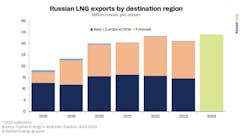Crude oil prices rose Sept. 11 despite weaker-than-expected economic data, buoyed by hope US Federal Reserve System officials will adopt a new program to stimulate the nation’s economy during their 2-day meeting that opened Sept. 12.
In Houston, analysts at Raymond James & Associates Inc. reported, “Natural gas markets gained nearly 5% on technical buying and expectations for another light weekly inventory build” in the US Energy Information Administration’s Sept. 13 report.
Analysts at Standard New York Securities Inc., the Standard Bank Group, said, “Crude oil markets exhibited the same upward bias as the other commodities for the most part yesterday, also with the same lackluster trading activity.” Oil prices were up in early trading Sept. 12 with the US dollar weakening against the euro. The front-month crude contract in the New York futures market is “firmly above its 200-day moving average,” Standard Bank analysts reported.
However, the Associated Press reported oil prices dipped following the release of EIA’s Sept. 12 report showing a build in US crude inventories. “The supply report erased gains seen after a German court cleared a path for Europe to create a fund to bail out financially troubled countries. That's one of several strategies Europe is pursuing to resolve its debt crisis,” AP reported (OGJ Online, Sept. 11, 2012).
The American Automobile Association reported an overnight 1.5¢ increase to an US average outlet pump price of $3.858/gal for gasoline. But more than 50 Lukoil-branded retail gasoline outlets in New Jersey and Pennsylvania raised their pump prices above $8/gal in protest of what they describe as unfair pricing practices by the Lukoil North America subsidiary of Russia's second-largest oil company, AP reported. Station operators claim through the New Jersey service station association that Lukoil’s pricing practices put them at a competitive disadvantage. Lukoil opened its first branded retail outlet in the US in 2003 and now has more than 500 in the Northeast and Mid-Atlantic.
In other news, the Bureau of Safety and Environmental Enforcement said in its final update on the effects of Hurricane Isaac that crews had returned to all but 2 of the 596 manned platforms and 1 of the 76 rigs in the Gulf of Mexico as of midday Sept. 11. However, 4.16% of daily oil production and 4.73% of daily gas production from federal leases in the gulf remain shut in.
US inventories
The EIA said Sept. 12 commercial US crude inventories increased 2 million bbl to 359.1 million bbl in the week ended Sept. 7, an above-average total for this time of year. Analysts were expecting a “relatively strong” draw of 2.9 million bbl. Gasoline stocks fell 1.2 million bbl to 197.7 million bbl in the same period, less than the 1.7 million bbl draw some expected. Finished gasoline increased while blending components decreased. Distillate fuel inventories rose 1.5 million bbl to 128.6 million bbl, yet remained below average. Analysts were expecting a 500,000-bbl dip.
“Drawdowns would be a relief, especially as it becomes increasingly evident that oil market participants remain caught between concerns over the dire consequences for demand should the US economy be faltering and the more optimistic view of a weaker US economy inevitably leading to further quantitative easing” from the Fed, said Standard Bank analysts prior to the EIA report.
The American Petroleum Institute earlier reported US crude stocks inched up by 221,000 bbl to 359 million bbl last week, while gasoline inventories fell 4.16 million bbl to 197.7 million bbl. It said distillate stocks rose 2.5 million bbl to 128.9 million bbl.
Imports of crude into the US increased 530,000 b/d to 8.6 million b/d last week, EIA officials said. In the 4 weeks through Sept. 7, US crude imports averaged 8.6 million b/d, down 298,000 b/d from the comparable period a year ago. Gasoline imports last week averaged 799,000 b/d, while distillate fuel imports averaged 144,000 b/d.
The input of crude into US refineries was down 287,000 b/d to 14.3 million b/d in the first week of September, partially because of Hurricane Isaac that hit Louisiana the last week August, temporarily reducing refining capacity in that state and shutting in most of the oil production from federal leases in the Gulf of Mexico. US refineries operated at 84.7% of capacity last week. Gasoline production decreased to 9 million b/d while distillate fuel production increased to 4.4 million b/d.
Energy prices
The October contract for benchmark US light, sweet crudes continued its seven-session rally, up 63¢ to $97.17/bbl Sept. 11 on the New York Mercantile Exchange. The November contract advanced 62¢ to $97.50/bbl. On the US spot market, West Texas Intermediate at Cushing, Okla., followed the front-month crude futures contract up 63¢ to $97.17/bbl.
Heating oil for October delivery increased 1.89¢ to $3.19/gal on NYMEX. Reformulated stock for oxygenate blending for the same month gained 1.95¢ to $3.04/gal.
The October natural gas contract continued to escalate, jumping 18¢ to $2.99/MMbtu on NYMEX. On the US spot market, gas at Henry Hub, La., regained 15.7¢ to $2.84/MMbtu.
In London, the October IPE contract for North Sea Brent rose 59¢ to $115.40/bbl. Gas oil for September climbed $8.25 to $996.50/tonne.
The average price for the Organization of Petroleum Exporting Countries’ basket of 12 benchmark crudes increased 36¢ to $112.68/bbl.
Contact Sam Fletcher at [email protected].

